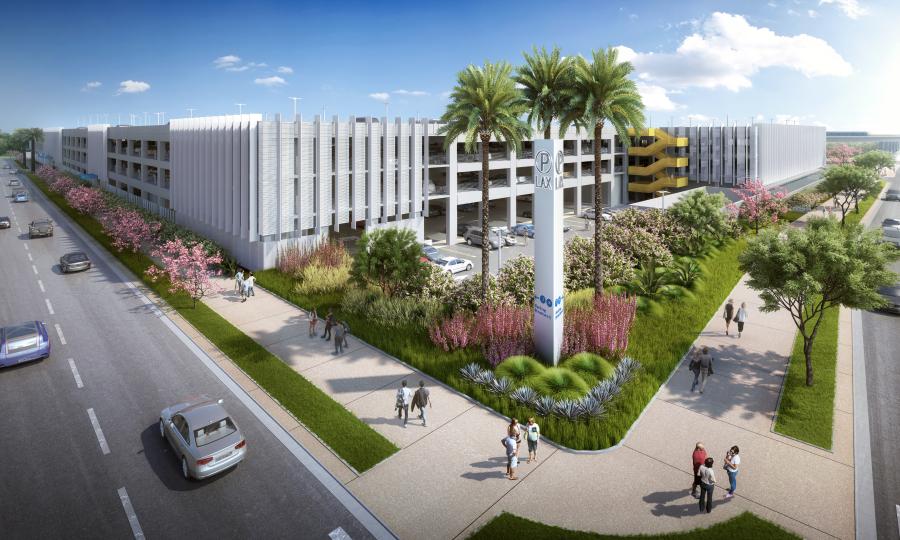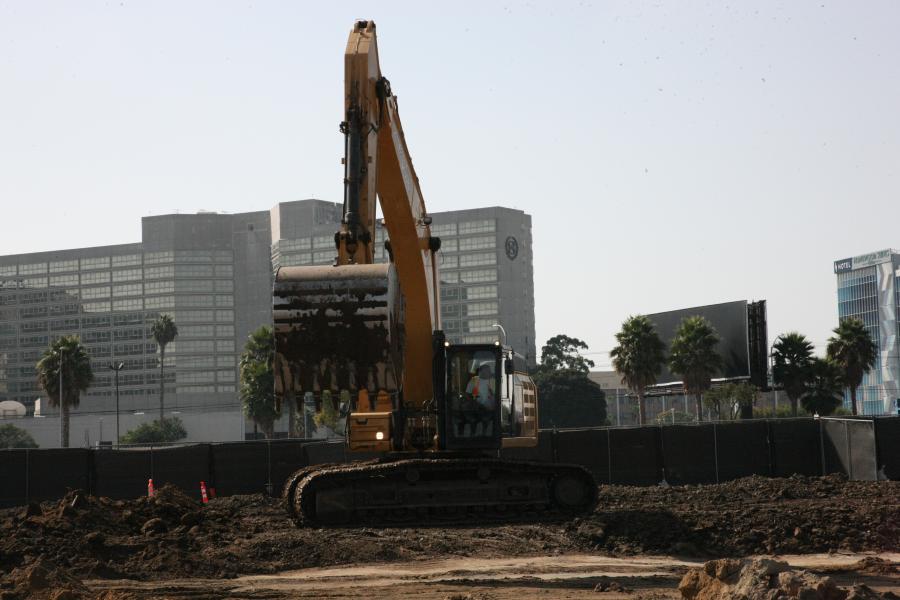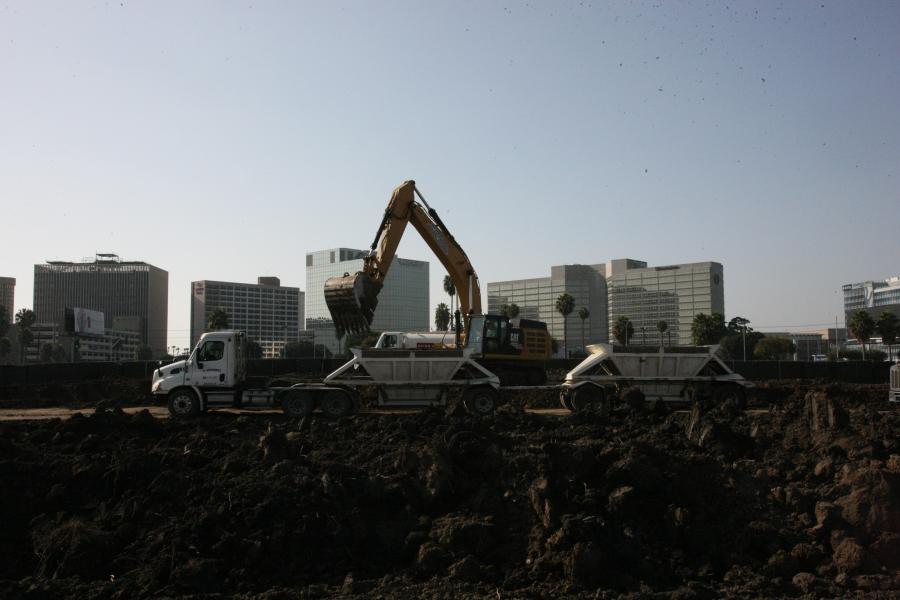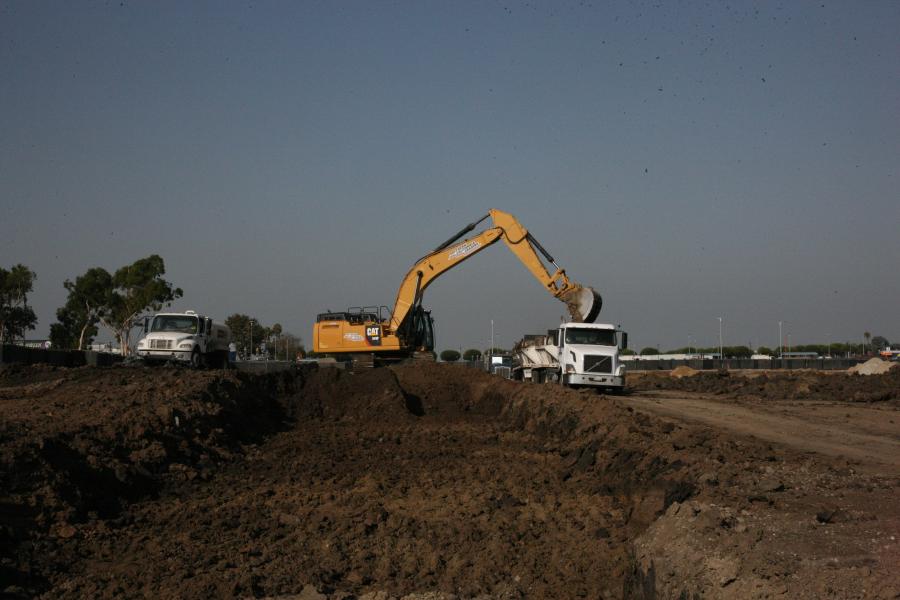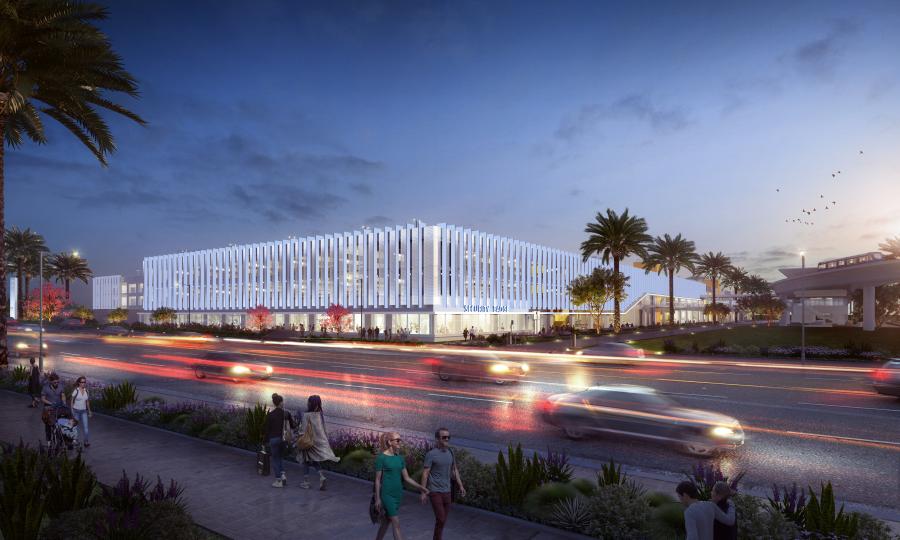As part of one of the largest public works projects in California history, the new Intermodal Transportation Facility-West (ITF-West) will play a key role in LAX’s $5.5 billion Landside Access Modernization Program (LAMP).
(Jeff Moye photo)
As part of one of the largest public works projects in California history, the new Intermodal Transportation Facility-West (ITF-West) will play a key role in LAX's $5.5 billion Landside Access Modernization Program (LAMP). When it opens in 2021, ITF-West will offer short and long-term parking options and direct connection to the Automated People Mover (APM) system.
"The ITF-West will be the first component completed of the LAMP, providing a much-needed option for pick-up/drop-off outside the Central Terminal Area [CTA] during the height of construction," said Stephanie Sampson, director of communications of LAMP. "It's more than just a parking structure, because it offers intermodal options. LAX is future-proofing the facility, which allows it to adjust to changes in transportation in the future."
In addition to parking, the ITF-West will provide valet service, "meet & greet" space and commercial curb area and circulation roads that would allow the airport to bring a multitude of transportation modes into a facility outside the CTA.
"It will also go above and beyond code requirements for electrical vehicle [E/V] charging infrastructure," said Sampson. "The facility will also feature Smart Parking technology like green/red lights for open/taken parking stalls and signage showing how many open spots on each level. These features will help reduce vehicle idling and lower emissions."
LAX is in the midst of a $14.3 billion capital improvement program and is focused on improving facilities, providing options for guests and employees and creating a fully-connected airport with time-guaranteed access to the terminals. This project, and others in the works, are considered crucial in creating a world-class airport.
Sampson said the project also will feature sustainable elements.
"Los Angeles World Airports [LAWA] has a vested commitment in creating a strong and sustainable business. Sustainable elements are just one way we are committed to this process. We want to make sure the impact we have on our neighboring communities and at the airport is one that benefits, not causes more harm."
The facility is a four-structure complex with approximately 4,500 parking stalls. LAWA intends to fund the ITF-West design-build contract with airport cash/revenues. No city, state or federal tax revenues are expected to be used to support the $219 million project.
According to Sampson, the ITF-West will make travel easier for passengers.
"It will provide new options for pick-up/drop-off outside of the crowded CTA. With the facility opening in 2021, when the airport is at the height of construction, guests and employees can avoid the terminal area congestion by picking up or dropping off at the ITF-West. A shuttle bus will transport to and from the terminal area until 2023, when the APM opens. Once the APM opens, passengers will be to their terminal within minutes."
Construction began in August 2019. The majority of work takes place behind barriers, which limits public access to any work. As on any job site, the safety of all workers in the field is a top concern.
"Both the developer and LAWA have safety managers ensuring proper protocols are followed. Safety on public streets when trucks are hauling away debris or making deliveries is also a priority. The contractor provides flaggers to assist drivers and pedestrians to ensure safe exit and entry into the job site."
Swinerton Builders serves as the general contractor for the project, with work taking place Monday-Friday from 6 a.m. to 3 p.m. Since the majority of this project is behind barricades, the potential to work during off-peak hours could occur in the future.
"During the peak period of construction, an estimated 250 workers will be on site at one time, and total construction jobs during the project could be in excess of 450," said Sampson. "Swinerton also has a 30 percent local hire commitment, and expects to use dozens of apprentices throughout the course of the project."
The undertaking is the result of years of detailed planning.
"The LAMP project has been in the making since the early 2000s. Once the final environmental impact report was released, LAWA moved forward putting plans into reality. The Request for Proposals [RFP] was released in July 2017. The LAWA Board of Airport Commissioners awarded the design-build contract to Swinerton Builders in July 2018.
"This is an amazing and exciting project," said Swinerton superintendent Jeff Moye. "The ITF-West will take two years to complete, and the scope of the project will be challenging. It will require synchronizing and harmonizing the work of a myriad of subcontractors to a precise schedule, in order to keep the project progressing and on budget, while coordinating with multiple adjacent contractors and projects all part of the overall LAMP development. Our primary goal will be providing peace of mind and minimizing the impacts of construction to the traveling public at the nation's second busiest airport."
Currently, crews are focused on earthwork and soil hauling, LID and dry wells construction and certification of building pads. Foundation work was expected to commence in November. Tasks already completed include site demolition west of Jenny Avenue and Building Pad A certification. Remaining work includes Building Pad B certification, site demolition and concrete pouring.
Moye said building new roadways requires a great deal of coordination.
"One of the first things you have to do is grade the area, so you have everything leveled out. You have to install utilities, including electrical duct banks, storm drains, reclaimed water lines and sewer lines. On top of that, landscape projects usually coincide with roadway construction. The civil portion requires installation of sidewalks, curbs, ramps and asphalt paving, followed by signage and striping. Traffic signal installation involves coordination with the Department of Transportation or other entities having jurisdictional authority of that area."
Over the next two months, workers will excavate 70,000 cu. yds. of dirt, which if stacked, would equal the height of nearly 200 skyscrapers.
"We will be using many different types of heavy earthmoving equipment, which will require the expertise of our seasoned operators and laborers to accomplish this highly orchestrated task," said Moye. "Of course, during all of this, we will also need to minimize impact to air quality and ensure dust migration, so we will also need to ensure streets are routinely cleaned as we haul away this significant sum of dirt. Additionally, excavating and exporting soils on a project this substantial will also mean that we will need to minimize disruption to traffic around one of the busiest airports in the world."
Moye said weather is often the most unpredictable issue the crew faces.
"A little bit of rain, for instance, might not affect the project at all. On the other hand, an El Niño winter that can result in significantly more rain than usual, can tremendously slow down or bring a certain aspect of the project to a halt altogether. In situations like this, we can't excavate, move dirt or pour concrete. The net result of weather is that it can massively disrupt what is already a finely orchestrated schedule of a myriad of subcontractors.
"We have contingency plans for the schedule, but Mother Nature often requires us to write and rewrite the schedule on nearly a daily basis. We must be nimble, change agile and adept at making and communicating the necessary changes to keep everything moving along and get back on schedule. We have worked hard with LAWA and leveraging our company's 131-year construction experience to include a responsible and appropriate amount of weather allowance in our construction schedule."
Moye noted that the Security & Badging Office will be constructed within the footprint of the parking structure, although details can't be released for security reasons. Building the concession spaces and APM bridge connections, meanwhile, requires significant teamwork.
"On a project this size and complex, communication with our fellow LAMP partners, including The City of Los Angeles inspection teams, LADWP and key stakeholders, is crucial. Nothing is done without comprehensive planning and preparation for our city's and LAWA's combined success."
As for infrastructure for Smart Parking, said Moye, "It goes in with the electrical phase of this project; however, this is the sleeping giant, and doesn't wake until the final phase of the project when all activities are on critical path. All of the infrastructure will be concealed in the concrete, and to the traveling public, they will only see the smart parking devices themselves. Having this indispensable feature helps the weary traveler find their parking spot quickly and easily for a low stress parking and traveling experience."
The former Lot ‘C' parking lot was housed where the ITF-West building is being constructed. It was a large parking lot with potholes, uneven asphalt and light poles. Moye said the demolition phase wasn't particularly long or complicated, based on the Roadway Utility Enabling team's hard work forging the way to move AVIS to their new location prior to crews breaking ground.
"There was, however, intensive plan research, underground utility scanning and potholing to locate, identify and cap all of the old utilities before we started the demolition phase of this project. The demolition phase of Lot ‘C' parking took three months and we will finish this up in October. The old Lot ‘C' parking area consisted mostly of A/C paving that was trucked to the new Rams/Chargers stadium to be recycled."
Equipment being used to carry out work on the ITF-West includes scrapers, Caterpillar 623K, tractors, excavators, Case, forklifts, rollers, boom and trenchers. Concrete is the main material required to complete the project.
Moye added that scheduling and coordination will be one of the most challenging aspects of work involved.
"It will involve significant time, communication and effort to synchronize all of the moving pieces, to ensure the project runs smoothly."
Said Sampson, "It's incredibly rewarding to see the transformation of LAX under way. The modernization program has been in the works for many years, and to see it finally start to take shape is exciting for not only LAX, but the nearly 90 million people who travel to and from the airport." CEG
Cindy Riley
Birmingham, Ala., native Cindy RIley originally planned on a career in law, but during her sophomore year in college realized journalism was her true calling. A magna cum laude graduate of Samford University, Riley first worked in radio and TV. Named Best News Anchor, Best News Reporter and Best Investigative Reporter by the Associated Press, she interviewed numerous personalities, ranging from Dr. Henry Kissinger and President Bush to Michael Jordan and Captain Kangaroo.
As a print journalist, Riley has covered a variety of topics, including construction, business, health and the arts. In addition to CEG, her work has appeared in special reports for USA Today and the L.A. Times. Other publications have included New South Magazine, Portico, Thicket, Alabama Heritage, B-Metro, Business First and Birmingham Business Journal.
Read more from Cindy Riley here.
Today's top stories



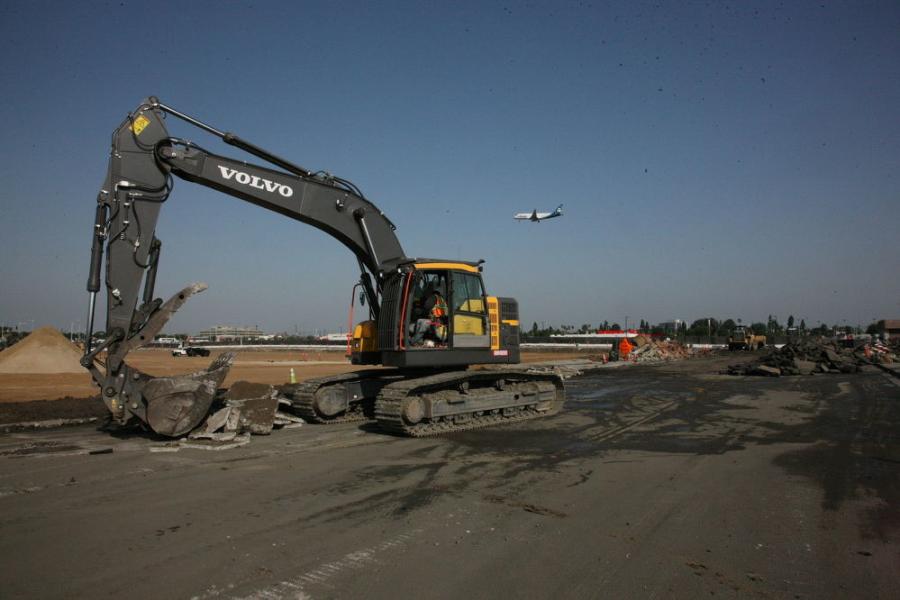





![“The ITF-West will be the first component completed of the LAMP, providing a much-needed option for pick-up/drop-off outside the Central Terminal Area [CTA] during the height of construction,” said Stephanie Sampson, director of communications of LAMP.
(Los Angeles World Airports rendering)](https://dmt55mxnkgbz2.cloudfront.net/0x76_s3-46962-W-CA-336_19-CR-6.jpg)

